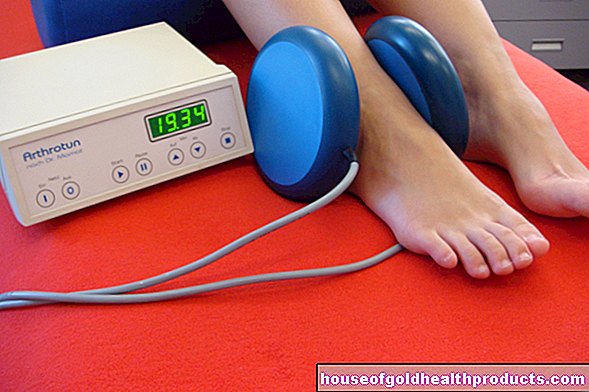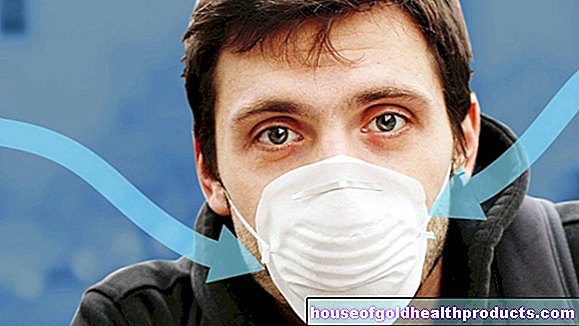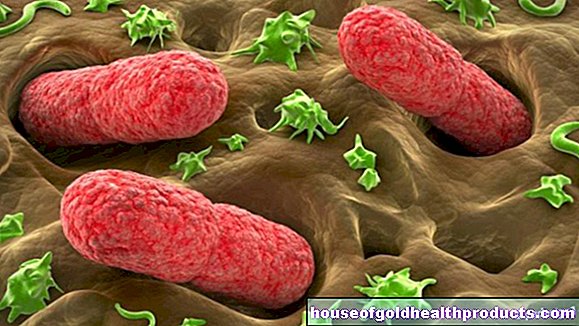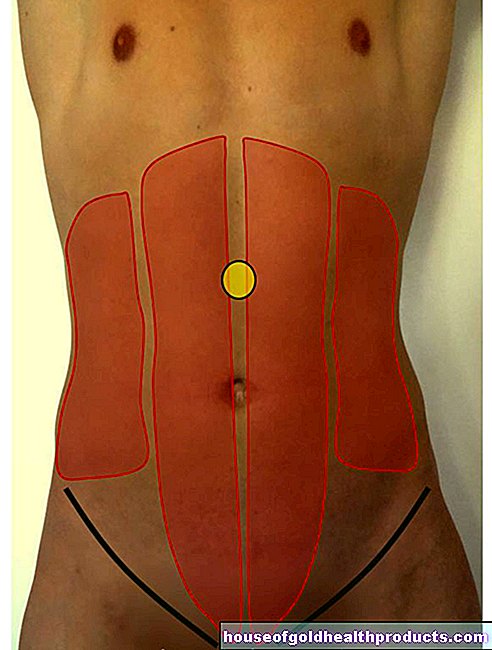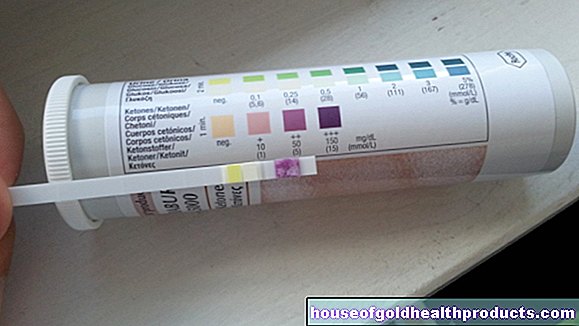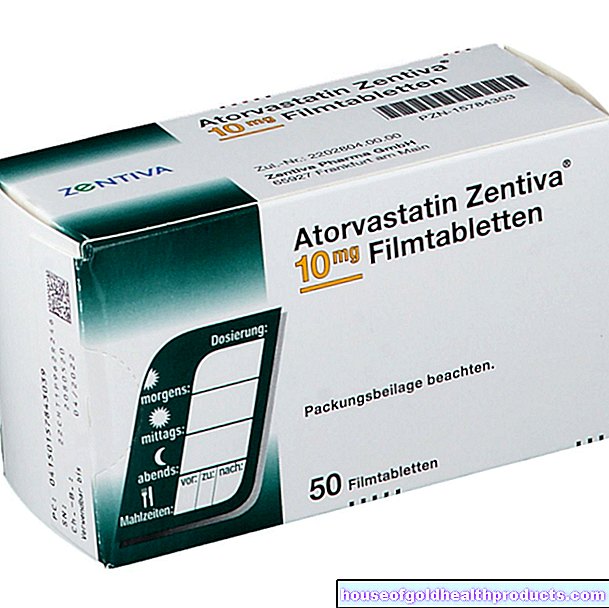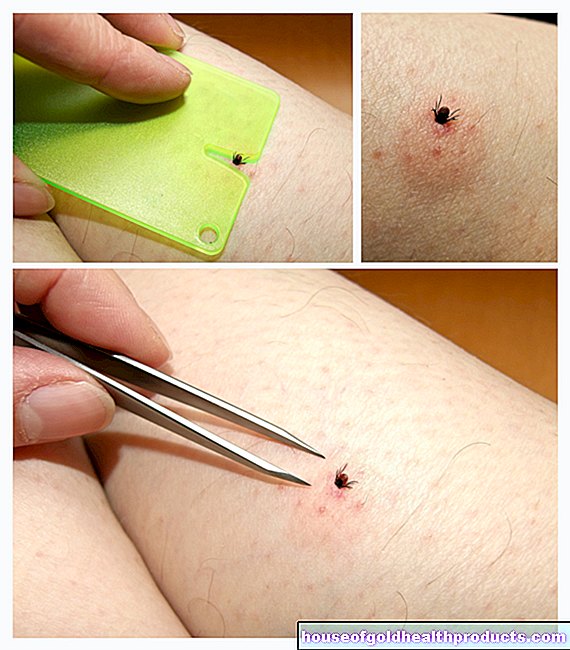Acromegaly
All content is checked by medical journalists.Acromegaly is a condition in which the body makes too much growth hormone. It is characterized by an extraordinarily strong increase in body size or certain parts of the body such as hands, feet or nose. In most cases, the trigger is a benign tumor of the pituitary gland (pituitary gland). It is possible to treat acromegaly well. If left untreated, it will shorten life expectancy. Read more about symptoms, treatment and aftercare here!
ICD codes for this disease: ICD codes are internationally recognized codes for medical diagnoses. They can be found, for example, in doctor's letters or on certificates of incapacity for work. E22
Brief overview
- Description: an overproduction of growth hormone that leads to a growth disturbance; mostly caused by a benign brain tumor
- Symptoms: gigantism, enlargement of the acra (extremities of the body) on the face as well as on the hands and feet, high blood pressure, diabetes mellitus
- Prognosis: If the acromegaly is left untreated, life expectancy is reduced by about ten years.
- Diagnostics: blood tests (IGF-1, GH), MRI
- Treatment: Surgical, medicinal or radiation therapy
- Causes: 99 percent of the time, a benign pituitary gland tumor (somatotropic pituitary adenoma) is the cause.
- Follow-up care: Acromegaly may have many comorbidities for which regular follow-up care is important.
What is acromegaly?
Acromegaly is a rare disease caused by overproduction of the growth hormone somatotropin. In 99 percent of cases, the cause is a benign tumor of the pituitary gland. Doctors refer to this tumor as somatotropic pituitary adenoma. The appearance of acromegaly depends on age and leads to both external changes in the body and other concomitant diseases.
If the disease already shows up in childhood, before the growth plates of the bones have closed, a so-called gigantism develops. With this form of acromegaly, colloquially also referred to as giant stature, those affected are taller than average. If the growth plates close beforehand - acromegaly does not occur until after the age of 20 - only certain parts of the body, the so-called acra (body extremities, body tips), continue to grow on the face, hands and feet.
Acromegaly also affects internal organs (e.g. heart, large intestine) to some extent. Concomitant diseases such as type 2 diabetes mellitus, high blood pressure or osteoarthritis are also common in people with acromegaly.
What does acromegaly look like?
The symptoms of acromegaly vary widely. Whether the entire body or just individual parts of the body grow strongly depends primarily on the age at which the person affected develops the disease. There are also other typical side symptoms and accompanying illnesses.
The most common symptoms of acromegaly, in descending order, include:
- Enlarged acra such as the nose, chin, fingers, toes (in 86 percent of those affected)
- Changed jaw and facial skull (in 74 percent)
- Profuse sweating (in 48 percent)
- Aching joints (in 46 percent)
- Headache (40 percent)
- Signs of hormonal disorders in the gonads such as ovaries or testicles (in 38 percent)
- Visual disturbances (in 26 percent)
Gigantism: Acromegaly in childhood
Acromegaly in childhood leads to gigantism. In people who develop acromegaly before the growth plate (epiphyseal plate) of the long bones closes, so-called giant growth or gigantism appears. The growth plate usually closes by the age of 20. Long bones are, for example, upper arm or thigh bones. They are responsible for the growth in length.
In gigantism, the length of the body is increased in total and proportionally. Doctors define gigantism using growth curves that describe body height measurements at a certain age (percentile) and determine when there is a deviation. Giant stature is defined as a height above the 97th percentile.
If the acromegaly takes a severe course, the shape of the spine also changes. Those affected develop a hunched back with a deformed chest, especially if they develop acromegaly at a young age.
Acromegaly in adulthood
If acromegaly occurs after the growth plate of the bones has closed, i.e. after the age of 20, only certain parts of the body, the acra, enlarge. These are the extremities or tips of the body such as fingers, toes, chin and nose. This is where cartilage and bone cells multiply.
The hands and feet become wider, the fingers are usually short and thick. For example, those affected often have to have their rings widened over time. Shoe size also increases in adulthood.
Acromegaly changes the face: Typical are a wide and thickened nose and prominent cheekbones. The forehead bulges outwards. The upper and / or lower jaw grow, resulting in misalignment of the teeth. Over the years the teeth move apart and there are gaps between the teeth. Internal organs can also be affected.
Side symptoms and comorbidities of acromegaly
Acromegaly is associated with changes in the skin. The majority of those affected sweat more, especially at night. The skin's collagen production is increased, it is often thickened and oily. Headaches are common, regardless of the size of the pituitary gland tumor.
In addition, the voice tends to become deeper and more sonorous over time. The reason for this is that the cartilage in the larynx thickens and the sound spaces of the voice, the sinuses and the frontal sinus enlarge.
Acromegaly and the cardiovascular system
Acromegaly leads to various diseases of the cardiovascular system. Up to 50 percent of patients have high blood pressure (arterial hypertension). This occurs more often the longer the disease persists. The increased pressure is triggered by the high blood volume and other concomitant diseases.
In people with acromegaly, the heart also changes over time: for example, it enlarges or the heart valves no longer work as they should. Increasing heart problems, including shortness of breath, are the result, initially only under stress, later also at rest. Cardiac arrhythmias also occur.
Even if acromegaly is successfully treated, it is advisable to have regular check-ups, especially of the heart. The doctor checks the blood pressure, pulse and the general function of the heart.
Effects on breathing
At least half of people with acromegaly, especially males, have sleep apnea syndrome. This is characterized by short-term and unconscious breathing pauses during sleep. Those affected often snore heavily. Daytime sleepiness and headaches in the morning are indications of sleep apnea.
In people with acromegaly, the jaw changes, and the soft tissue in the throat thickens and becomes more inflexible. The tongue grows too. All of these contribute to the development of this breathing disorder. Since sleep apnea is associated with an increased mortality rate, it is advisable to consult a doctor and seek treatment if you experience symptoms. Sometimes sleep apnea improves when acromegaly is treated, and sometimes symptoms persist. The symptoms of sleep apnea (especially breathing pauses) can be brought under control with a breathing apparatus (CPAP).
Effects on the skeleton
People with acromegaly often have joint pain because the joint spaces of the knees, shoulders, hands and hips sometimes widen. All over the body, the bone and cartilage tissue thickens and the tendons and ligaments ossify. In addition to the joints, the chest hardens and becomes more inflexible overall, which in turn causes breathing difficulties.
The spine is also affected in 40 to 50 percent of patients. Back pain, especially in the lower back, is common. In addition, fractures (fractures) of individual vertebral bodies often occur.
Metabolic diseases in acromegaly
Acromegaly is often accompanied by diabetes mellitus (20 to 56 percent) and glucose intolerance (16 to 46 percent). In addition, the blood lipid levels are often increased. Both are related to the fact that the increased release of growth hormone affects the blood sugar level and blood lipids.
Drug treatment of acromegaly affects glucose metabolism. Regular checks by a doctor are therefore advisable.
Acromegaly also affects the thyroid. Many patients develop goiter, commonly known as goiter, in which the thyroid tissue increases. In addition, disorders of the sex hormones lead to a reduced sensation of pleasure, erectile dysfunction in men and menstrual cycle disorders in women.
Increased cancer risk and acromegaly?
People with acromegaly are at increased risk of thyroid cancer and colon cancer. For this reason, regular preventive examinations are advisable, especially for those over 40 years of age. Since the large intestine is often elongated in acromegaly, a colonoscopy is recommended by an experienced doctor.
Effects on the nervous system
Acromegaly also affects the nervous system. Joint pain and headaches are common consequences. The symptoms are often improved by medication. Exercise and relaxation exercises help support.
Furthermore, the carpal tunnel syndrome is typical of acromegaly. Here a nerve in the wrist is constricted by the surrounding tissue and hurts as a result. In the context of neurological concomitant diseases, psychological disorders are also to be expected. Many people suffer from depression or have problems with memory and attention.
What is the life expectancy with acromegaly?
If left untreated, acromegaly shortens life expectancy: Affected people die around ten years earlier than healthy people. There are now good treatment options, especially since so-called somatostatin analogues - drugs against acromegaly - have become available. How effectively the production or release of growth hormone is controlled after the therapy is decisive for the course of the disease.
Although some symptoms, such as joint pain, persist or physical changes in the face or hands and feet persist during treatment, treatment improves the quality of life. Regular monitoring of possible comorbidities is very important.
How do people with acromegaly die?
Often people with acromegaly die from the accompanying heart disease, from complications that arise with breathing, or from cancer. So-called cerebrovascular diseases, i.e. a disturbed blood supply to the brain due to diseased blood vessels such as arteries or veins, are also among the common causes of death in acromegaly.
How common is acromegaly?
Acromegaly is not common, it is a rare disease. Around three to six thousand people across Germany have acromegaly. In this country, around 250 to 330 people are newly diagnosed each year. It usually takes about five to eight years after the first signs of the disease before those affected are diagnosed with acromegaly.
How is acromegaly diagnosed?
The typical symptoms give the doctor the first indications of acromegaly. He then ensures the diagnosis using certain examination methods. In the first place is the blood test, in which the following values are determined:
- IGF-1 ("Insulin-like growth factor 1"): If this value is not increased, there is a high probability that there is no acromegaly.
- GH (growth hormone): If the IGF-1 value is increased, the GH value is checked. During this test, the patient is given glucose and blood drawn every 30 minutes for two hours. The GH value is not as meaningful as the IGF-1 value.
If there is any suspicion that more growth hormones are being made than normal, doctors will look at the area where the body makes these hormones: the pituitary gland. Magnetic resonance imaging (MRI) of the brain or the sella turcica area of the brain - the so-called Turk's saddle, a depression in the skull at the level of the nose - shows whether a tumor is possibly present here.
How is acromegaly treated?
Basically, acromegaly therapy is about shrinking the pituitary gland tumor and thus normalizing the increased secretion of growth hormone.
There are various ways of doing this: Ideally, a surgeon will remove the adenoma (benign tumor that originates from glands) of the pituitary gland through an operation. If this is not possible or not completely possible, drugs or radiation therapy are used to control the disease.
Surgery for acromegaly
Neurosurgeons perform the surgical treatment for acromegaly. Since their experience is crucial for a successful therapy, it is advisable to contact a specialist center for such an intervention.
In pituitary adenoma surgery, the tumor is usually removed through the nose. The region of the skull in which the pituitary gland is located, namely the Turkish saddle (sella turcica) and the sphenoid sinus (sphenoid sinus), can be easily reached through the nose. The operation is usually minimally invasive using an endoscope - the doctor tries to damage as little tissue as possible.
The procedure is successful in more than 90 percent of those affected and symptoms of acromegaly improve. The risk of dying in the procedure is less than 0.5 percent. Serious complications, such as reduced blood flow or bleeding in the brain as well as infections, occur in 1.5 percent of cases. It is possible that the pituitary gland tumor will come back, the probability of this occurring five years after the procedure is two to eight percent.
Medication
Medicines for the treatment of acromegaly, the so-called somatostatin analogues, have only been available since the early 2000s. Somatostatin is a hormone; it inhibits growth hormone (somatotropin) in the body. Somatostatin analogs are man-made hormones that are administered to patients with acromegaly by regular injections in an adjusted dose.
There are two different drugs that doctors currently use for acromegaly: lanreaotide and octreotide.They use them, for example, in patients who cannot be operated on or irradiated, in whom the operation or irradiation was unsuccessful, or who require medication for another reason.
In the majority of patients (60 percent), the tumor shrinks when they take the medication. In other affected persons (17 to 35 percent) the IGF-1 value normalizes, although this depends on the initial situation of the disease (size of the tumor, previous operation, laboratory values). Common side effects are gastrointestinal complaints and, among other things, local pain at the injection site.
If the somatostatin analogs do not bring the desired success, there are other drugs that the doctor may use in acromegaly under certain conditions.
radiotherapy
Radiation therapy for acromegaly is used when surgery is not possible or when the tumor cannot be completely removed. The radiation is usually carried out for five to six weeks with four to five sessions per week. The effect of radiation therapy is delayed in acromegaly: an effect only occurs after several years, which is why those affected should take medication up to this point.
Radiation therapy can cause neurological changes. Among other things, the radiation can lead to an underfunction of the pituitary gland as well as psychological and neurological secondary diseases. To prevent this, the irradiation takes place very precisely and is checked with the help of imaging devices (such as MRI). For this reason, doctors primarily seek surgical or drug treatment for acromegaly.
What is important in aftercare?
Even after successful treatment of acromegaly, it is necessary to have yourself checked at regular intervals. On the one hand, laboratory tests are used to determine whether the growth hormones are still within the normal range. In addition, an MRI three to six months after an operation and one year after the start of drug therapy and radiation therapy is recommended. If the acromegaly persists, regular MRIs are advisable.
On the other hand, it is important to identify possible secondary diseases quickly. Since cardiovascular diseases are one of the most common causes of death in patients with acromegaly, it is advisable to have your doctor regularly check for high blood pressure or cardiac arrhythmias, for example. As part of the follow-up care, it is advisable to have other comorbidities such as sleep apnea, diabetes mellitus, thyroid diseases and malignant changes in the thyroid or intestines checked regularly.
What causes acromegaly?
Acromegaly is caused in over 99 percent of cases by a benign tumor of the pituitary gland, the somatotropic pituitary adenoma. Another region of the brain such as the hypothalamus is rarely responsible for this. The fact that the hypothalamus increasingly secretes another hormone - which then also leads to acromegaly - is an exception. The causes of this overproduction of the hypothalamus are in particular lung cancer or tumors in certain parts of the pancreas or the adrenal glands.
It is also rare that acromegaly is passed on in the family. If this form does occur, young men in particular are affected. In this case, the actually benign adenoma grows very strongly and is more difficult to treat with the somatostatin analogs.
Tags: healthy feet desire to have children magazine




